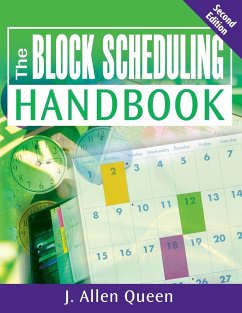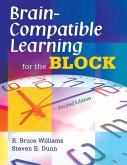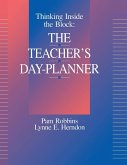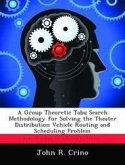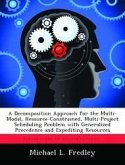J. Allen Queen
The Block Scheduling Handbook
J. Allen Queen
The Block Scheduling Handbook
- Broschiertes Buch
- Merkliste
- Auf die Merkliste
- Bewerten Bewerten
- Teilen
- Produkt teilen
- Produkterinnerung
- Produkterinnerung
This step-by-step resource offers three block schedule models, sample lessons, instructional strategies, and templates to get a successful alternative scheduling program up and running.
Andere Kunden interessierten sich auch für
![Questions & Answers About Block Scheduling Questions & Answers About Block Scheduling]() John BrucatoQuestions & Answers About Block Scheduling28,99 €
John BrucatoQuestions & Answers About Block Scheduling28,99 €![Brain-Compatible Learning for the Block Brain-Compatible Learning for the Block]() R. Bruce WilliamsBrain-Compatible Learning for the Block41,99 €
R. Bruce WilliamsBrain-Compatible Learning for the Block41,99 €![Thinking Inside the Block Thinking Inside the Block]() Pam RobbinsThinking Inside the Block42,99 €
Pam RobbinsThinking Inside the Block42,99 €![The Block Plan Preschool Parent Handbook The Block Plan Preschool Parent Handbook]() Katy HarderThe Block Plan Preschool Parent Handbook19,99 €
Katy HarderThe Block Plan Preschool Parent Handbook19,99 €![A Group Theoretic Tabu Search Methodology for Solving the Theater Distribution Vehicle Routing and Scheduling Problem A Group Theoretic Tabu Search Methodology for Solving the Theater Distribution Vehicle Routing and Scheduling Problem]() John R. CrinoA Group Theoretic Tabu Search Methodology for Solving the Theater Distribution Vehicle Routing and Scheduling Problem64,99 €
John R. CrinoA Group Theoretic Tabu Search Methodology for Solving the Theater Distribution Vehicle Routing and Scheduling Problem64,99 €![A Decomposition Approach for the Multi-Modal, Resource-Constrained, Multi-Project Scheduling Problem with Generalized Precedence and Expediting Reso A Decomposition Approach for the Multi-Modal, Resource-Constrained, Multi-Project Scheduling Problem with Generalized Precedence and Expediting Reso]() Michael L. FredleyA Decomposition Approach for the Multi-Modal, Resource-Constrained, Multi-Project Scheduling Problem with Generalized Precedence and Expediting Reso63,99 €
Michael L. FredleyA Decomposition Approach for the Multi-Modal, Resource-Constrained, Multi-Project Scheduling Problem with Generalized Precedence and Expediting Reso63,99 €![School Leadership - Heads on the Block? School Leadership - Heads on the Block?]() Pat ThomsonSchool Leadership - Heads on the Block?61,99 €
Pat ThomsonSchool Leadership - Heads on the Block?61,99 €-
-
-
This step-by-step resource offers three block schedule models, sample lessons, instructional strategies, and templates to get a successful alternative scheduling program up and running.
Hinweis: Dieser Artikel kann nur an eine deutsche Lieferadresse ausgeliefert werden.
Hinweis: Dieser Artikel kann nur an eine deutsche Lieferadresse ausgeliefert werden.
Produktdetails
- Produktdetails
- Verlag: Corwin
- 2. Auflage
- Seitenzahl: 290
- Erscheinungstermin: 19. Dezember 2008
- Englisch
- Abmessung: 280mm x 216mm x 16mm
- Gewicht: 736g
- ISBN-13: 9781412963015
- ISBN-10: 141296301X
- Artikelnr.: 25051589
- Herstellerkennzeichnung
- Libri GmbH
- Europaallee 1
- 36244 Bad Hersfeld
- gpsr@libri.de
- Verlag: Corwin
- 2. Auflage
- Seitenzahl: 290
- Erscheinungstermin: 19. Dezember 2008
- Englisch
- Abmessung: 280mm x 216mm x 16mm
- Gewicht: 736g
- ISBN-13: 9781412963015
- ISBN-10: 141296301X
- Artikelnr.: 25051589
- Herstellerkennzeichnung
- Libri GmbH
- Europaallee 1
- 36244 Bad Hersfeld
- gpsr@libri.de
J. Allen Queen is professor and former chair of the Department of Educational Leadership at The University of North Carolina at Charlotte. A former classroom teacher, principal, college administrator, and university professor, he works with teachers and principals in the areas of managing priorities, time management, and stress reduction. Queen has written over 30 books and 70 articles, including The Frazzled Teacher's Wellness Plan (Corwin Press 2004), The Block Scheduling Handbook (Corwin Press 2002), and books on karate and fitness for young readers. He has appeared on radio and television programs, including ABC¿s World News Now, and has been a consultant to over 160 schools and districts in 36 states and 3 foreign countries in the areas of classroom discipline, school safety, block scheduling, and time management.
Dedication and Acknowledgments About the Author 1. The Current Status of Block Scheduling 2. Block Scheduling and the High School 3. Developmental Aspects of Growth and Behavior Physical Development From Early Childhood Through Adolescence Cognitive Growth Characteristics of Piaget
s Stages of Cognitive Development Schemata and the Process of Assimilation, Accomodation, and Equilibration The Sensori-Motor Period The Period of Preoperational Thought The Period of Concrete Operations The Period of Formal Operations Cognitive Theory and Block Instruction Personality Development Erikson
s Stages of Personality Development Implications of Erikson
s Theory for Block Instruction 4. Building the Block Culture in the School 5. Selecting the Best Fit The 4
4 Block Schedule Model The A/B Block Schedule Model The Modified Block New Lesson Designs for the Block 6. Block Scheduling in the Middle School The Middle School Defined Characteristics of the Middle School Team Teaching Interdisciplinary Teaming Block Classes or Periods Advisory Programs Benefits of the Block Schedule in the Middle School Shortfalls of the Traditional Schedule The Flexible/Alternate/Navigate (FAN) Models Advantages of Modified Schedules in the Middle School Teaching in the Block in the Middle School Summary 7. The Elementary School on the Block Historical Events Impacting the Elementary School National Initiatives America 2000 Part 1: For Today
s Students, Better, More Accountable Schools Part 2: For Tomorrow
s Students, a New Generation of American Schools Part 3: For the Rest of Us (Yesterday
s Students and Today
s Workforce), a Nation of Students Part 4: Communities Where Learning Can Happen Goals 2000: Educate America Act A State Example: The Elementary Curriculum in North Carolina Technology English Language Arts Mathematics Science Social Studies Fine Arts: Dance Fine Arts: Music Fine Arts: Theater Fine Arts: Visual Arts Organizational Patterns Disadvantages of Graded Arrangement Alternative Possibilities for Scheduling 4-Blocks Model for Elementary Education Parallel Block Scheduling Summary 8. Aligning Standards and Course Content Models for Use of Instructional Time Limiting Content Notes to Remember Assigning Outside Content Integrating Content: C-Clustering Curriculum Alignment and Instructional Pacing Curriculum Alignment Phase 1 Curriculum Alignment Phase 2 Instructional Pacing Phase 1 Instructional Pacing Phase 2 9. Sample of Curriculum Alignment and Pacing 10. Effective Instructional Strategies for Block Scheduling Cooperative Learning The Case Method Socratic Seminar Synectics Concept Attainment Inquiry Method Simulations Recommendations for Improving Block Scheduling for the Future 11. Teacher-Directed Instruction Direct Instruction as a Teaching Model Direct Instruction as a Continuum of Teaching Behaviors Summary Our Mr. Jefferson: A Sample Teacher-Directed Lesson 12. Discovery and Inquiry Discovery Learning History and Research Promises and Pitfalls Summary The Inquiry Training Model History and Research Promises and Pitfalls Summary Building the Tower: A Sample Discovery Method Activity 13. Simulations and Role Play Simulations Forms for the Simulation Model Rationale for Appropriate Use Lesson Design History and Research Promises and Pitfalls Summary Gifted and Talented Simulation: A Sample Lesson Using Simulation 14. Cooperative Learning History and Research Promises and Pitfalls The Case Method Summary Building the Perfect School: A Cooperative Staff Development Activity 15. Synectics History and Research Gordon
s Stages of Creativity Promises and Pitfalls Summary To Kill a Mockingbird: A Syectics Sample Lesson 16. Socratic Seminar Group Discussion and Student Participation What Happened: A Socratic Seminar 17. Instructional Assessment Methods of Instructional Evaluation Presassessment Formative Assessment Summative Assessment Assessment of Student Acheivement Portfolio Unit Evaluation Lesson Evaluation A Positive Classroom Climate Through Instruction 18. Program Evaluation and Student Assessment Reasons for Evaluation Defining Program Evaluation Instructional Evaluation Summary Evaluation Resource 1: Block Schedule Teacher Survey Evaluation Resource 2: Teacher Survey: High School Instruction 19. A Guide to Traditional and Authentic Assessment Writing and Evaluating Test Items Parts of a Test Item Categorizing Items on Cognitive Levels Evaluating Test Items Using Authentic Assessment for Student Evaluation The Trouble With Tests Is... What Is Authentic Assessment? Brain Growth, Brain Enrichment, and Attention Effective Implementation of Authentic Assessment Multiple Intelligences and Authentic Assessment Types of Authentic Assessment References, Recommended Readings Internet Resources Index
s Stages of Cognitive Development Schemata and the Process of Assimilation, Accomodation, and Equilibration The Sensori-Motor Period The Period of Preoperational Thought The Period of Concrete Operations The Period of Formal Operations Cognitive Theory and Block Instruction Personality Development Erikson
s Stages of Personality Development Implications of Erikson
s Theory for Block Instruction 4. Building the Block Culture in the School 5. Selecting the Best Fit The 4
4 Block Schedule Model The A/B Block Schedule Model The Modified Block New Lesson Designs for the Block 6. Block Scheduling in the Middle School The Middle School Defined Characteristics of the Middle School Team Teaching Interdisciplinary Teaming Block Classes or Periods Advisory Programs Benefits of the Block Schedule in the Middle School Shortfalls of the Traditional Schedule The Flexible/Alternate/Navigate (FAN) Models Advantages of Modified Schedules in the Middle School Teaching in the Block in the Middle School Summary 7. The Elementary School on the Block Historical Events Impacting the Elementary School National Initiatives America 2000 Part 1: For Today
s Students, Better, More Accountable Schools Part 2: For Tomorrow
s Students, a New Generation of American Schools Part 3: For the Rest of Us (Yesterday
s Students and Today
s Workforce), a Nation of Students Part 4: Communities Where Learning Can Happen Goals 2000: Educate America Act A State Example: The Elementary Curriculum in North Carolina Technology English Language Arts Mathematics Science Social Studies Fine Arts: Dance Fine Arts: Music Fine Arts: Theater Fine Arts: Visual Arts Organizational Patterns Disadvantages of Graded Arrangement Alternative Possibilities for Scheduling 4-Blocks Model for Elementary Education Parallel Block Scheduling Summary 8. Aligning Standards and Course Content Models for Use of Instructional Time Limiting Content Notes to Remember Assigning Outside Content Integrating Content: C-Clustering Curriculum Alignment and Instructional Pacing Curriculum Alignment Phase 1 Curriculum Alignment Phase 2 Instructional Pacing Phase 1 Instructional Pacing Phase 2 9. Sample of Curriculum Alignment and Pacing 10. Effective Instructional Strategies for Block Scheduling Cooperative Learning The Case Method Socratic Seminar Synectics Concept Attainment Inquiry Method Simulations Recommendations for Improving Block Scheduling for the Future 11. Teacher-Directed Instruction Direct Instruction as a Teaching Model Direct Instruction as a Continuum of Teaching Behaviors Summary Our Mr. Jefferson: A Sample Teacher-Directed Lesson 12. Discovery and Inquiry Discovery Learning History and Research Promises and Pitfalls Summary The Inquiry Training Model History and Research Promises and Pitfalls Summary Building the Tower: A Sample Discovery Method Activity 13. Simulations and Role Play Simulations Forms for the Simulation Model Rationale for Appropriate Use Lesson Design History and Research Promises and Pitfalls Summary Gifted and Talented Simulation: A Sample Lesson Using Simulation 14. Cooperative Learning History and Research Promises and Pitfalls The Case Method Summary Building the Perfect School: A Cooperative Staff Development Activity 15. Synectics History and Research Gordon
s Stages of Creativity Promises and Pitfalls Summary To Kill a Mockingbird: A Syectics Sample Lesson 16. Socratic Seminar Group Discussion and Student Participation What Happened: A Socratic Seminar 17. Instructional Assessment Methods of Instructional Evaluation Presassessment Formative Assessment Summative Assessment Assessment of Student Acheivement Portfolio Unit Evaluation Lesson Evaluation A Positive Classroom Climate Through Instruction 18. Program Evaluation and Student Assessment Reasons for Evaluation Defining Program Evaluation Instructional Evaluation Summary Evaluation Resource 1: Block Schedule Teacher Survey Evaluation Resource 2: Teacher Survey: High School Instruction 19. A Guide to Traditional and Authentic Assessment Writing and Evaluating Test Items Parts of a Test Item Categorizing Items on Cognitive Levels Evaluating Test Items Using Authentic Assessment for Student Evaluation The Trouble With Tests Is... What Is Authentic Assessment? Brain Growth, Brain Enrichment, and Attention Effective Implementation of Authentic Assessment Multiple Intelligences and Authentic Assessment Types of Authentic Assessment References, Recommended Readings Internet Resources Index
Dedication and Acknowledgments About the Author 1. The Current Status of Block Scheduling 2. Block Scheduling and the High School 3. Developmental Aspects of Growth and Behavior Physical Development From Early Childhood Through Adolescence Cognitive Growth Characteristics of Piaget
s Stages of Cognitive Development Schemata and the Process of Assimilation, Accomodation, and Equilibration The Sensori-Motor Period The Period of Preoperational Thought The Period of Concrete Operations The Period of Formal Operations Cognitive Theory and Block Instruction Personality Development Erikson
s Stages of Personality Development Implications of Erikson
s Theory for Block Instruction 4. Building the Block Culture in the School 5. Selecting the Best Fit The 4
4 Block Schedule Model The A/B Block Schedule Model The Modified Block New Lesson Designs for the Block 6. Block Scheduling in the Middle School The Middle School Defined Characteristics of the Middle School Team Teaching Interdisciplinary Teaming Block Classes or Periods Advisory Programs Benefits of the Block Schedule in the Middle School Shortfalls of the Traditional Schedule The Flexible/Alternate/Navigate (FAN) Models Advantages of Modified Schedules in the Middle School Teaching in the Block in the Middle School Summary 7. The Elementary School on the Block Historical Events Impacting the Elementary School National Initiatives America 2000 Part 1: For Today
s Students, Better, More Accountable Schools Part 2: For Tomorrow
s Students, a New Generation of American Schools Part 3: For the Rest of Us (Yesterday
s Students and Today
s Workforce), a Nation of Students Part 4: Communities Where Learning Can Happen Goals 2000: Educate America Act A State Example: The Elementary Curriculum in North Carolina Technology English Language Arts Mathematics Science Social Studies Fine Arts: Dance Fine Arts: Music Fine Arts: Theater Fine Arts: Visual Arts Organizational Patterns Disadvantages of Graded Arrangement Alternative Possibilities for Scheduling 4-Blocks Model for Elementary Education Parallel Block Scheduling Summary 8. Aligning Standards and Course Content Models for Use of Instructional Time Limiting Content Notes to Remember Assigning Outside Content Integrating Content: C-Clustering Curriculum Alignment and Instructional Pacing Curriculum Alignment Phase 1 Curriculum Alignment Phase 2 Instructional Pacing Phase 1 Instructional Pacing Phase 2 9. Sample of Curriculum Alignment and Pacing 10. Effective Instructional Strategies for Block Scheduling Cooperative Learning The Case Method Socratic Seminar Synectics Concept Attainment Inquiry Method Simulations Recommendations for Improving Block Scheduling for the Future 11. Teacher-Directed Instruction Direct Instruction as a Teaching Model Direct Instruction as a Continuum of Teaching Behaviors Summary Our Mr. Jefferson: A Sample Teacher-Directed Lesson 12. Discovery and Inquiry Discovery Learning History and Research Promises and Pitfalls Summary The Inquiry Training Model History and Research Promises and Pitfalls Summary Building the Tower: A Sample Discovery Method Activity 13. Simulations and Role Play Simulations Forms for the Simulation Model Rationale for Appropriate Use Lesson Design History and Research Promises and Pitfalls Summary Gifted and Talented Simulation: A Sample Lesson Using Simulation 14. Cooperative Learning History and Research Promises and Pitfalls The Case Method Summary Building the Perfect School: A Cooperative Staff Development Activity 15. Synectics History and Research Gordon
s Stages of Creativity Promises and Pitfalls Summary To Kill a Mockingbird: A Syectics Sample Lesson 16. Socratic Seminar Group Discussion and Student Participation What Happened: A Socratic Seminar 17. Instructional Assessment Methods of Instructional Evaluation Presassessment Formative Assessment Summative Assessment Assessment of Student Acheivement Portfolio Unit Evaluation Lesson Evaluation A Positive Classroom Climate Through Instruction 18. Program Evaluation and Student Assessment Reasons for Evaluation Defining Program Evaluation Instructional Evaluation Summary Evaluation Resource 1: Block Schedule Teacher Survey Evaluation Resource 2: Teacher Survey: High School Instruction 19. A Guide to Traditional and Authentic Assessment Writing and Evaluating Test Items Parts of a Test Item Categorizing Items on Cognitive Levels Evaluating Test Items Using Authentic Assessment for Student Evaluation The Trouble With Tests Is... What Is Authentic Assessment? Brain Growth, Brain Enrichment, and Attention Effective Implementation of Authentic Assessment Multiple Intelligences and Authentic Assessment Types of Authentic Assessment References, Recommended Readings Internet Resources Index
s Stages of Cognitive Development Schemata and the Process of Assimilation, Accomodation, and Equilibration The Sensori-Motor Period The Period of Preoperational Thought The Period of Concrete Operations The Period of Formal Operations Cognitive Theory and Block Instruction Personality Development Erikson
s Stages of Personality Development Implications of Erikson
s Theory for Block Instruction 4. Building the Block Culture in the School 5. Selecting the Best Fit The 4
4 Block Schedule Model The A/B Block Schedule Model The Modified Block New Lesson Designs for the Block 6. Block Scheduling in the Middle School The Middle School Defined Characteristics of the Middle School Team Teaching Interdisciplinary Teaming Block Classes or Periods Advisory Programs Benefits of the Block Schedule in the Middle School Shortfalls of the Traditional Schedule The Flexible/Alternate/Navigate (FAN) Models Advantages of Modified Schedules in the Middle School Teaching in the Block in the Middle School Summary 7. The Elementary School on the Block Historical Events Impacting the Elementary School National Initiatives America 2000 Part 1: For Today
s Students, Better, More Accountable Schools Part 2: For Tomorrow
s Students, a New Generation of American Schools Part 3: For the Rest of Us (Yesterday
s Students and Today
s Workforce), a Nation of Students Part 4: Communities Where Learning Can Happen Goals 2000: Educate America Act A State Example: The Elementary Curriculum in North Carolina Technology English Language Arts Mathematics Science Social Studies Fine Arts: Dance Fine Arts: Music Fine Arts: Theater Fine Arts: Visual Arts Organizational Patterns Disadvantages of Graded Arrangement Alternative Possibilities for Scheduling 4-Blocks Model for Elementary Education Parallel Block Scheduling Summary 8. Aligning Standards and Course Content Models for Use of Instructional Time Limiting Content Notes to Remember Assigning Outside Content Integrating Content: C-Clustering Curriculum Alignment and Instructional Pacing Curriculum Alignment Phase 1 Curriculum Alignment Phase 2 Instructional Pacing Phase 1 Instructional Pacing Phase 2 9. Sample of Curriculum Alignment and Pacing 10. Effective Instructional Strategies for Block Scheduling Cooperative Learning The Case Method Socratic Seminar Synectics Concept Attainment Inquiry Method Simulations Recommendations for Improving Block Scheduling for the Future 11. Teacher-Directed Instruction Direct Instruction as a Teaching Model Direct Instruction as a Continuum of Teaching Behaviors Summary Our Mr. Jefferson: A Sample Teacher-Directed Lesson 12. Discovery and Inquiry Discovery Learning History and Research Promises and Pitfalls Summary The Inquiry Training Model History and Research Promises and Pitfalls Summary Building the Tower: A Sample Discovery Method Activity 13. Simulations and Role Play Simulations Forms for the Simulation Model Rationale for Appropriate Use Lesson Design History and Research Promises and Pitfalls Summary Gifted and Talented Simulation: A Sample Lesson Using Simulation 14. Cooperative Learning History and Research Promises and Pitfalls The Case Method Summary Building the Perfect School: A Cooperative Staff Development Activity 15. Synectics History and Research Gordon
s Stages of Creativity Promises and Pitfalls Summary To Kill a Mockingbird: A Syectics Sample Lesson 16. Socratic Seminar Group Discussion and Student Participation What Happened: A Socratic Seminar 17. Instructional Assessment Methods of Instructional Evaluation Presassessment Formative Assessment Summative Assessment Assessment of Student Acheivement Portfolio Unit Evaluation Lesson Evaluation A Positive Classroom Climate Through Instruction 18. Program Evaluation and Student Assessment Reasons for Evaluation Defining Program Evaluation Instructional Evaluation Summary Evaluation Resource 1: Block Schedule Teacher Survey Evaluation Resource 2: Teacher Survey: High School Instruction 19. A Guide to Traditional and Authentic Assessment Writing and Evaluating Test Items Parts of a Test Item Categorizing Items on Cognitive Levels Evaluating Test Items Using Authentic Assessment for Student Evaluation The Trouble With Tests Is... What Is Authentic Assessment? Brain Growth, Brain Enrichment, and Attention Effective Implementation of Authentic Assessment Multiple Intelligences and Authentic Assessment Types of Authentic Assessment References, Recommended Readings Internet Resources Index

